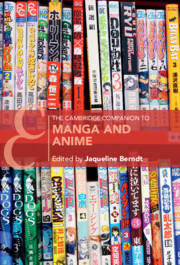Book contents
- The Cambridge Companion to Manga and Anime
- The Cambridge Companion to Manga and Anime
- Copyright page
- Contents
- Figures
- Contributors
- Acknowledgments
- Notes on Japanese Names, Terms, and Titles
- Chronology
- Introduction
- Part I Claimed Origins and Overlooked Traditions
- 1 Premodern Roots of Story-Manga?
- 2 Newspaper Comic Strips
- 3 Astro Boy and the “Weaponized” Children of Wartime Japan
- Part II Drawing and Movement
- Part III Sound
- Part IV Narrative
- Part V Characters
- Part VI Genres
- Part VII Forms of Production
- Part VIII Forms of Distribution
- Part IX Forms of Use
- Further Reading
- Index
- Cambridge Companions to Literature
3 - Astro Boy and the “Weaponized” Children of Wartime Japan
from Part I - Claimed Origins and Overlooked Traditions
Published online by Cambridge University Press: 07 November 2024
- The Cambridge Companion to Manga and Anime
- The Cambridge Companion to Manga and Anime
- Copyright page
- Contents
- Figures
- Contributors
- Acknowledgments
- Notes on Japanese Names, Terms, and Titles
- Chronology
- Introduction
- Part I Claimed Origins and Overlooked Traditions
- 1 Premodern Roots of Story-Manga?
- 2 Newspaper Comic Strips
- 3 Astro Boy and the “Weaponized” Children of Wartime Japan
- Part II Drawing and Movement
- Part III Sound
- Part IV Narrative
- Part V Characters
- Part VI Genres
- Part VII Forms of Production
- Part VIII Forms of Distribution
- Part IX Forms of Use
- Further Reading
- Index
- Cambridge Companions to Literature
Summary
The character Astro Boy, which was called “child of science” in the 1963 anime series, is related here to Imperial Japan’s wartime policy of science. The term “child of science” was also applied to other characters at the time of the Asia-Pacific War, and intriguingly, the use of it covered not only mechanical but also human children. Seeking to find answers to the question of how such different things could be subsumed under the same term, the focus is on the empire’s policies and discourses of scientific warfare, and how they transformed children’s media of entertainment and education – manga, magazines, toys, and music – and even children’s bodies into weaponry at perceptual and physical levels. The issue of the “weaponization” of human bodies helps to reconsider the military traits and the subhuman qualities of Astro Boy. Extending this to Imperial Japan’s history of child soldiers, and conducting both intratextual and transtextual research of related anime and manga by Osamu Tezuka, this study brings to light the unnarrated life of Tobio, the human original of Astro Boy, as well as the implication of his premature death.
Keywords
- Type
- Chapter
- Information
- The Cambridge Companion to Manga and Anime , pp. 44 - 56Publisher: Cambridge University PressPrint publication year: 2024

